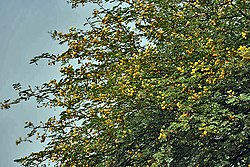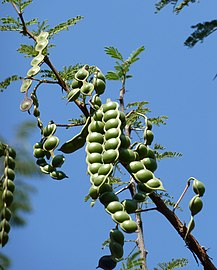| Revision as of 12:16, 19 September 2015 editWieralee (talk | contribs)Extended confirmed users6,631 editsm (GR) File renamed: File:Acac nilo Brk.jpg → File:Acacia nilotica bark.jpg File renaming criterion #2: To change from a meaningless or ambiguous name to a name that describes what the image displays.← Previous edit | Revision as of 14:27, 19 September 2015 edit undoMark Marathon (talk | contribs)Extended confirmed users4,594 edits →Gallery: Already one image of barkNext edit → | ||
| Line 72: | Line 72: | ||
| File:Acacia nilotica, peule, a, Uniegeboutuine.jpg|Seed pods | File:Acacia nilotica, peule, a, Uniegeboutuine.jpg|Seed pods | ||
| File:Acacia-nilotica.jpg|Compound leaf, seed, flower and seed pod | File:Acacia-nilotica.jpg|Compound leaf, seed, flower and seed pod | ||
| File:Acacia nilotica bark.jpg|Bark structure | |||
| </gallery> | </gallery> | ||
Revision as of 14:27, 19 September 2015
| Vachellia nilotica | |
|---|---|

| |
| Scientific classification | |
| Kingdom: | Plantae |
| (unranked): | Angiosperms |
| (unranked): | Eudicots |
| (unranked): | Rosids |
| Order: | Fabales |
| Family: | Fabaceae |
| Genus: | Vachellia |
| Species: | V. nilotica |
| Binomial name | |
| Vachellia nilotica (L.) P.J.H.Hurter & Mabb. | |
| subspecies | |
| |

| |
| Range of Vachellia nilotica | |
| Synonyms | |
Vachellia nilotica (widely known by the taxonomic synonym Acacia nilotica, or the common names gum arabic tree, Babul/Kikar, Egyptian thorn, Sant tree, Al-sant or prickly acacia; called thorn mimosa or prickly acacia in Australia; lekkerruikpeul or scented thorn in South Africa; karuvela maram in South India) is a species of Vachellia native to Africa, the Middle East and the Indian subcontinent. It is also currently an invasive species of significant concern in Australia.
Taxonomy
This tree was originally the type species of the genus Acacia, which derives its name from ακακία (akakia), the name given by early Greek botanist-physician Pedanius Dioscorides (ca. 40–90) to this tree as a medicinal, in his book Materia Medica. The renaming of the genus to Vachellia remains controversial .
The genus name Acacia derives from the Greek word for its characteristic thorns, ακις (akis, thorn). The species name nilotica was given by Linnaeus from this tree's best-known range along the Nile river. The plant V. nilotica then, in turn, became the type species for the Linnaean Acacia genus (not all of which have thorns, even though they are named for them). For the ongoing reclassification of this and other species historically classified under genus Acacia, see the Acacia.
Description

Vachellia nilotica is a tree 5–20 m high with a dense spheric crown, stems and branches usually dark to black coloured, fissured bark, grey-pinkish slash, exuding a reddish low quality gum. The tree has thin, straight, light, grey spines in axillary pairs, usually in 3 to 12 pairs, 5 to 7.5 cm (3 in) long in young trees, mature trees commonly without thorns. The leaves are bipinnate, with 3–6 pairs of pinnulae and 10–30 pairs of leaflets each, tomentose, rachis with a gland at the bottom of the last pair of pinnulae. Flowers in globulous heads 1.2–1.5 cm in diameter of a bright golden-yellow color, set up either axillary or whorly on peduncles 2–3 cm long located at the end of the branches. Pods are strongly constricted, hairy, white-grey, thick and softly tomentose. Its seeds number approximately 8000/kg.
Distribution
Vachellia nilotica is native from Egypt, across the Maghreb and Sahel, south to Mozambique and KwaZulu-Natal, South Africa, and east through Arabian Peninsula to Pakistan, India and Burma. It has become widely naturalised outside its native range including Zanzibar and Australia. Vachellia nilotica is spread by livestock.
Uses
Forage and fodder
In part of its range smallstock consume the pods and leaves, but elsewhere it is also very popular with cattle. Pods are used as a supplement to poultry rations in India. Dried pods are particularly sought out by animals on rangelands. In India branches are commonly lopped for fodder. Pods are best fed dry as a supplement, not as a green fodder.
Teeth Brushing
The tender twig of this plant is used as a toothbrush in south-east Africa and India.
Hedges
V. nilotica makes a good protective hedge because of its thorns.
Lumber

The tree's wood is "very durable if water-seasoned" and its uses include tool handles and lumber for boats. The wood has a density of about 1170 kg/m³.
Propagation
There are 5000–16000 seeds/kg.
Gallery
See also
- List of Indian timber trees
- Arid Forest Research Institute (AFRI)
- Babool (brand) of toothpast
- Teeth cleaning twig (datun)
References
- Kyalangalilwa B, Boatwright JS, Daru BH, Maurin O, van der Bank M. (2013). "Phylogenetic position and revised classification of Acacia s.l. (Fabaceae: Mimosoideae) in Africa, including new combinations in Vachellia and Senegalia". Bot J Linn Soc. 172 (4): 500–523. doi:10.1111/boj.12047.
{{cite journal}}: CS1 maint: multiple names: authors list (link) - ^ Wickens, G.E. (1995). "Table 2.1.2 The timber properties of Acacia species and their uses". Role of Acacia species in the rural economy of dry Africa and the Near East. FAO Conservation Guide. Vol. 27. Food and Agriculture Organization of the United Nations. ISBN 92-5-103651-9.
{{cite book}}: External link in|chapterurl=|chapterurl=ignored (|chapter-url=suggested) (help) - USDA, ARS, National Genetic Resources Program. "Acacia nilotica". USDA Germplasm Resources Information Network (GRIN).
{{cite web}}: CS1 maint: multiple names: authors list (link) - ILDIS LegumeWeb "Acacia nilotica". LegumeWeb. International Legume Database & Information Service.
{{cite web}}: Check|url=value (help) - "Vachellia nilotica (as Acacia nilotica (L.) Willd. ex Delile)". Integrated Taxonomic Information System.
- Babul dictionary_infoplease
- Babul_Mirriam Webster
- AgroForestryTree Database_World AgroForestry Centre
- "Acacia nilotica (acacia)". Plants & Fungi. Royal Botanic Gardens, Kew. Archived from the original on 12 January 2010. Retrieved 2010-01-28.
{{cite web}}: Unknown parameter|deadurl=ignored (|url-status=suggested) (help) - Quattrocchi, Umberto (2000). CRC World Dictionary of Plant Names. Vol. 1 A-C. CRC Press. p. 6. ISBN 978-0-8493-2675-2.
- Handbook on Seeds of Dry-zone Acacias FAO
- ^ "Prickly acacia – Acacia nilotica" (PDF). Weed Management Guide. Weeds of National Significance. 2003. ISBN 1-920932-14-3.
- Saurabh Rajvaidhya et al. (2012) "A review on Acacia Arabica, an Indian medicinal plant" International Journal of Pharmaceutical Sciences and Research Vol 3(7) pp 1995-2005
- A Hooda, M Rathee, J Singh (2009) "Chewing Sticks In The Era Of Toothbrush: A Review", The Internet Journal of Family Practice Vol 9(2)
- ^ Mueller, Ferdinand (1884). "Acacia longifolia, Willdenow". Select extra-tropical plants readily eligible for industrial culture or naturalization. G.S. Davis. p. 7.
{{cite book}}: External link in|chapterurl=|chapterurl=ignored (|chapter-url=suggested) (help) - "Vachellia nilotica (as Acacia nilotica)". Tropical Forages.
External links
- Carter, J.O. (1998). "7.2 Acacia nilotica: a Tree Legume out of Control". In Gutteridge, Ross C.; Shelton, H. Max (eds.). Forage Tree Legumes in Tropical Agriculture. The Tropical Grassland Society of Australia. ISBN 0-9585677-1-9.
{{cite book}}: External link in|chapterurl=|chapterurl=ignored (|chapter-url=suggested) (help) - "Vachellia nilotica (as Acacia nilotica subsp. indica (Benth.) Brenan)". FloraBase the West Australian Flora.
- Vachellia nilotica (as Acacia nilotica) (www.frienvis.nic.in)
| Sources of tannins | |||||||||||||||||
|---|---|---|---|---|---|---|---|---|---|---|---|---|---|---|---|---|---|
| Sources of condensed tannins |
| ||||||||||||||||
| Sources of hydrolysable tannins |
| ||||||||||||||||
| Other sources by organ |
| ||||||||||||||||
- Vachellia
- Drought-tolerant trees
- Forages
- Flora of Western Asia
- Flora of the Arabian Peninsula
- Trees of the Indian Subcontinent
- Plants used in Ayurveda
- Trees of the Middle East
- Trees of Africa
- Trees of Azerbaijan
- Trees of Myanmar
- Invasive plant species in Australia
- Flora naturalised in Australia
- Plants described in 1753

